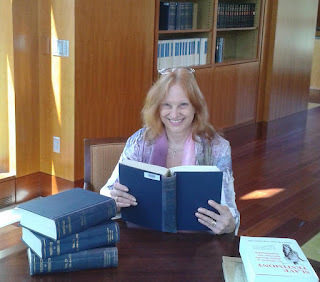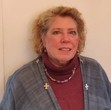Why I Write Historical Fiction - A Guest Blogpost from Diana Rubino
Diana Rubino's passion for history has taken her to every setting of her historical and biographical novels: England, France, Egypt, Italy, and all over the United States. With her husband Chris she's the owner of engineering business CostPro Inc., a golfer, pianist, fitness nut, Jersey Shore Italian, and real estate tycoon on the side. She spends as much time as possible living the dream on her beloved Cape Cod.
I enjoy meetingpeople from the past and how they fit into the major events of their lives.Writing historical fiction sends me back to the past, but keeps me grounded inreality.
My earliestrecollection of fascination with history was when I was 8 years old and myparents brought me to George Washington’s Mount Vernon. This was my first visitto a historic home. As the tour guide led us through the mansion, I felt astrong connection with the past and the people who lived there, as if theirenergy lingered. Deeply curious, I asked a million questions about theWashingtons, the estate’s history, the enslaved who ran the plantation. (an‘out of the mouths of babes’ moment was when we stood in Washington’s bedroomwhere he died in 1799, the guide told us he’d succumbed to a throat infection.I piped up, as the hypochondriac that I was, “Can we still catch it?”)
I visited manyhistoric places after that, but Mount Vernon became one of my favorites, and itbecame a huge part of my life when I wrote ONA JUDGE: I AM FREE, about MarthaWashington’s favorite servant.
When I was olderand realized that we all have a connection to history, as we’re all part of it,I became a true history buff. I hungered to learn about those who lived beforeus, and how they lived. They are so different from us and the way we live in modern times, but they were people, justlike us, with hopes, fears, goals, wishes, frustrations—they ate, slept, loved,grieved, took offense, worked, played, worshiped and experienced every emotionwe all do in our lives.
As I learned howmuch more difficult life was in the past, and how much harder it was to succeedat any endeavor, I developed a strong respect and admiration for our forebears.Reading biographies introduced me to these people on a more intimate level, asindividuals, and my appreciation for their struggles and their hardshipsintensified.
The more books Iread about women of the past, the more I felt connected to them as they becamemy heroines. I learned the stark reality of the difficulty of womens’ lives,not allowed to own property if married, not allowed to vote, their treatment assecond class citizens, subservient to their fathers, then to their husbands. Wewomen today take so much for granted.
I was alreadywriting romance novels, but contemporaries. One day I asked myself, “Why notwrite novels about the people who shaped their times, and made history happen,in those long-ago worlds that captivate me?” I’d always been interested theTudors—Henry VIII’s court, his wives, and his daughter Elizabeth who becameEngland’s greatest queen. I sat down and recreated that world, and the finishedproduct became THE JEWELS OF WARWICK. I then explored an era prior to theTudors—Richard III and his times. A kind and benevolent young king, unfairlymaligned and vilified, I got to know Richard and his world from the Richard IIISociety, and was delighted to find out that every member has a story about howthey ‘met’ Richard—his charismatic aura captures imaginations. I immersedmyself in his world and wrote a few books about him and the people surroundinghim, his friends, his family, his loves, his enemies. From then on, I knew I’dwrite only historicals, because I so enjoyed these journeys to the past, intolong-ago worlds, as I researched and walked in the footsteps of those who pavedthe way for us.
Writing fictionabout these unforgettable people gives me leeway to create what the historicalrecord didn’t leave behind—that, to me, is the joy of fiction. I deeply admirebiographers who must adhere to the historical record with every word, butfiction allows a world of make-believe to blend with verifiable events andfacts. And as a novelist, I make sure to add to my author’s notes at the end ofeach book disclaimers for having needed to fill in what the record left out.But as Mark Twain said, “Never let the truth get in the way of a good story,”as a novelist I delight in creating worlds based on the events these peoplelived, and the buildings, diaries, inventions, and artifacts they left behind.
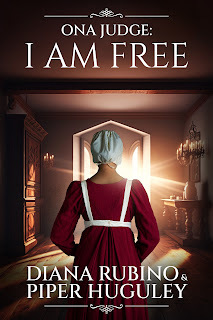
Find out more about Diana Rubino and her books at: www.DianaRubino.com
Blog host Helena P. Schrader is an award-winning novelist and author of six non-fiction and twenty historical fiction books. Her current project in a three-part series about the Berlin Airlift.
The first two volumes of the Bridge to Tomorrow Trilogy are now available.
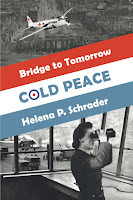
The first battle of the Cold War is about to begin....
Berlin 1948. In the ruins ofHitler’s capital, former RAF officers, a woman pilot, and the victim of Russianbrutality form an air ambulance company. But the West is on a collision coursewith Stalin’s aggression and Berlin is about to become a flashpoint. World WarThree is only a misstep away. Buy Now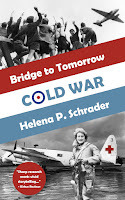
Berlin is under siege. More than twomillion civilians must be supplied by air -- or surrender to Stalin's oppression.
USAF Captain J.B. Baronowsky and RAF FlightLieutenant Kit Moran once risked their lives to drop high explosives on Berlin.They are about to deliver milk, flour and children’s shoes instead. Meanwhile,two women pilots are flying an air ambulance that carries malnourished andabandoned children to freedom in the West. Until General Winter deploys on theside of Russia. Buy now!
Based on historical events, award-winning and best-selling novelistHelena P. Schrader delivers an insightful, exciting and moving tale about howformer enemies became friends in the face of Russian aggression — and how closethe Berlin Airlift came to failing.
Winning a war with milk, coal and candy!

